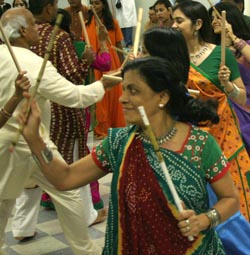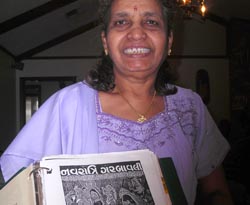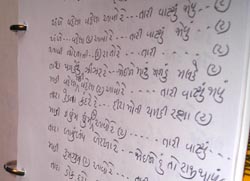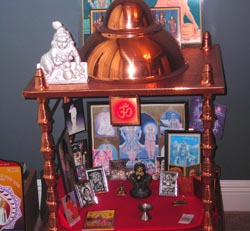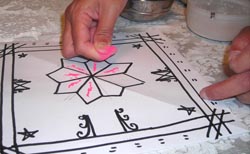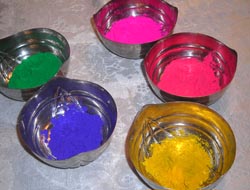Dancing in the Light: Navaratri
By Daria Woodside
Traveling across the Indian continent, especially in the rural areas, Louisiana natives could almost imagine being in Louisiana. In many areas, India looks very much like the magnolia state. Like Louisiana, India is filled with sugar cane and rice fields, and as in Louisiana, the people of India cut their cane and prepare it for grinding in the late fall season.
Since farming began, people of all cultures have gathered in autumn to thank god for the harvest and for the food that it provides. In several countries, harvest festivals are connected with goddess worship because it is believed that the feminine aspect of the divine provides good soil and crops. In India, and here in Louisiana for Indian Americans, the fall is a time to honor the goddess both as a fighter of the demons of the human mind, but also as Mother Earth who provides the food needed for survival.
In autumn, Indian Americans take nine days out of their lives for Navaratri, a celebration of the Divine Mother and her ability to overcome evil and provide for human needs. For those of the Hindu faith, god is worshipped as both male and female. This nine-day festival dedicated to the Divine Mother is celebrated at the time of the autumnal equinox during the Hindu month of Ashwin, which falls, according to the lunar calendar, around the end of September or beginning of October. "Nava" means nine, and "ratri" means night. For each of the nine nights of the celebration, a different aspect of the Divine Mother is worshipped. Three days are devoted to Lakshmi (the goddess of wealth and prosperity), three to Parvati or Durga (the warrior woman with ten arms that kills your demons), and three to Saraswati (the goddess of knowledge and the arts). On the tenth day, the festival culminates in a huge celebration called Dussera or Vijayadashami depending on the region which is filled with a variety of different cultural expressions celebrating the vctory of good over evil.
During Navaratri, the Indian community performs special dances like the garbha, raas, dandiya, and dhunuchi naach. They sing bhajans, beautiful songs honoring the Divine Mother and revealing their passionate love for her. The community creates elaborate and colorful flower garlands to decorate pictures and statues of goddesses, and women cook special dishes from the foods and grains associated with the season. It is a joyous time during which families pray together in the morning in their homes and then join the community in the evening in local temples for public worship, dance, music, and socialization.
Celebrating at Home
According to the 2000 census, at least 5,468 foreign-born Indians from almost every Indian state live in Louisiana. Therefore, celebrations vary widely and one would have to travel thousands of miles in India to see the diverse celebrations that happen in Baton Rouge alone. But 30 years ago, according to Shanta Ozo, a member of Hindu Samaj, only five Indian families lived in the Baton Rouge community, and the public gathering places, like the Datta Temple and Hall of Trinity, Hindu Vedic Center, and Hindu Samaj, did not exist, so, Navaratri was celebrated only in private homes. Ozo remembers that the Gujarati community, the largest Indian group in this area, first began to gather in the home of Dulat Sthanki to celebrate. "We would move the furniture and people would dance the garbha (a regional dance) and I would sing," she recalls. While traditional singing of garbha songs requires at least two singers, Shanta was the only one. "I had learned some songs from my mother in India and we began to collect books and tapes so I could learn more songs." Gradually, as more Indian families moved into the area, they began to rotate the celebration between houses. Ozo tells how these were organized: "We took turns, so that everybody had a chance to be part of the celebration. Next we started going to Ila Patel's house. We would do puja (a prayer ritual), bring food, and sing and dance together in each other's homes." Ozo taught a few others to join her as singers, and soon Bharati Patel joined the group. Patel remembers learning garbha songs in India because during Navaratri time they were sung on the radio. "As we worked around the house when I was a little girl," she recalls, "we learned the songs." Bharati's mother also sang garbha that she learned from her older sister. "It was all around us," Bharati explained, "so we just picked up the songs like that." Garbha songs are done in the form of call and response and one voice represents a woman praying to the Divine Mother and the second voice represents the goddess' answer to that prayer.
Unlike the past when the Indian community was small, the present diversity of Indian cultural practices is reflected in how Navaratri is celebrated in public spaces like the two temples and the Hindu Vedic Center; however, one common practice ties all of the groups together during Navaratri, and that is daily worship of the Divine Mother in private homes for each of the nine days of celebration.
It is a common Hindu custom to provide a space for god in the home. Many Indian families convert closets, a corner of a room, kitchen counters, or bookshelves into altars where daily prayers are said. On these altars are placed brass or stone murthies (statues) of Ganesh, the elephant-faced God; Nataraja, the dancing Shiva; and pictures of deities or of beloved gurus, saints, or spiritual masters. Most Hindus come from one of four primary sects, those who worship Shiva, Shavites; those who worship Vishnu, Vaishnavites; those who worship the Divine Mother; and those who worship all aspects of God, Smartas. However, all sects honor and worship the divine feminine form of god and also Lord Ganesh, the elephant-headed god who is worshipped at the beginning of all rituals because he is the giver and remover of obstacles.
While each home may worship the Divine Mother during this time, they may do so with a different name, depending on their region of origin. Here in Louisiana, the goddess is worshipped by a wide variety of names during this celebration because of the diversity among the Indian population. Bharati Patel, who refers to the Divine Mother or Devi as Amma or Amba, which means mother, says that during Navaratri, she worships the Navadurgas as Brahmini, Chamunda, Durga, Kalika, Karttiki, Lakshmi, and Mahamaya. At the Datta Temple and Hall of Trinity, the Devi is worshipped as Gauri, Raja Rajeshwari, Durga Lakshmi, Meenakshi, Parashakti, Vishalakshmi, Saraswati, Chandi, and Shakti Durgi. While the plethora of names may seem overwhelming to the westerner, in Hinduism, although gods and goddesses are represented in physical form and have distinct names, the overall concept of god is really monotheistic. All Hindu deities represent only cosmic energies or powers that are attributes of one god who embodies all of these attributes, both male and female, and is present in all living beings.
Dandina Rao, an LSU professor of petroleum engineering, who is a Vaishnavite, reports that he and his wife Chandrika begin Navaratri celebrations by cleaning their home and putting rangoli (special designs for welcoming guests and for good fortune made with ground stone or rice powder) in front of the house. "Everything has to be clean in and out," he explained. "The point is to have inner cleanliness and there is no eating before the morning puja on those days."
Like Dandino Rao, Amrita Dhurandhar also agrees that it is extremely important to clean one's house for Navaratri. "The goddess herself is going to be walking in your home," she said, "so you want everything to be at its best." Dhurandhar has a special rangoli pattern that she uses to place on her puja altar. "It's a way of creating a special place for the prayers," she said. Rao explained that the version of Saraswati (the goddess of knowledge and the arts) puja they do at home each day is very abbreviated from what their parents did in India because of time factors. In the morning they collect flowers from their backyard garden to offer on their altar, which is on a kitchen shelf. "Navaratri is a colorful celebration," Rao said, "I love those days because the altar radiates love and happiness and is filled with the beautiful color of flowers." His wife, too, draws rangoli at their front door during this season.
Shanta Ozo says that every day during Navaratri, she gets up early, showers, goes to her home altar, and offers kum kum (red decorative powder), a fresh homemade flower garland, and cooked rice. She sings songs and offers lighted oil lamps made of brass and filled with ghee (melted butter) for fuel. She does the same thing at night after coming home from singing the garbha at the Hindu Samaj, one of the Baton Rouge temples.
In addition to the emphasis on cleanliness, some Indians fast from all food except fruit and milk for nine days. Others fast for only the second and eighth, or tenth day because of special devotion to the aspects of the goddess being worshipped at that time or because of personal connections to the stories that inform that aspect of the celebration. Most fast from highly spiced foods or foods containing onions or garlic. Many women fast as a prayer for the health of their husbands.
According to Bharati Patel, Navaratri was historically a women's festival, a time when only women danced the garbha or were involved in rituals. While that restriction has passed and men are now included in Navaratri celebrations both in India and America, one custom practiced in some homes harkens back to the days when it was a time for women to get together. Historically, very young Indian girls were sent to live in the homes of their new husbands, whom they may have only met through arranged marriages. The parents of the little girls often gifted them with wooden dolls called Marapachi Bommai at the time of their marriage. The dolls are generally made of marapachi wood, which is believed to have medicinal properties. For those from southern Indian states like Karnataka and Andrha Pradesh, it is customary that each year, the girl will add a new doll to her collection, much the same as Americans might add a new Christmas tree ornament each year for display. While it is rare that girls are married that young in America, many families continue to have doll collections and to display them during this time. In southern India, it is common to display the dolls on the tenth day of Navaratri in a display called Bommai Kolu. Traditional Bommai Kolu includes a display of dolls representing gods and goddesses arranged amid an array of lighted oil lamps. However, collections are not limited to religious representations, and doll displays often showcase the varied, colorful, and wonderful folk traditions of India that include hand painting, wood carving, and the use of plants in making toys. American doll collections might include not only traditional Indian dolls, but Barbies and other popular toys. In some households, the dolls are placed on step-like shelves and left on display for the entire nine days. Friends come and visit in each other's homes to see each other's dolls just as Christians visit each other's homes to see Christmas trees and decorations and to celebrate the holiday season.
Another custom involving young girls is the Kumari puja. Only a few families practice this ritual in Baton Rouge and, according to Raju Hingorani, it is more frequently practiced in private homes here in Louisiana than in public. However, during the 2006 Hindu Vedic Center celebrations of Navaratri, Kumari puja was celebrated before lighting Ravana's effigy on Dussera, another name for the tenth day of celebrations. Kumari puja is the ritual worship of virgins from ages one to 16. Usually, nine little girls are dressed in their finest clothes and are seated on chairs holding flowers. Because the young girls are seen as incarnations of the Divine Mother in a young and virginal form, they are worshiped with all of the usual puja traditions of flowers, rice, lighted lamps, incense, and kum kum (a decorative red powder). After the ceremony, prasad is offered to those present, as it would be for any formal ritual. Many believe this ceremony indicates the reverence that Hinduism holds for women. Dandina Rao believes that the celebration of Navaratri and the attention given to the Divine Mother indicate what importance women play in this tradition. "Women play an important role in Hinduism," he said. "For me, Durga represents valor!"
Temple Celebrations
In Baton Rouge, the Datta Temple and Hall of Trinity is the focus of the more structured religious practices that surround the celebration of Navaratri. Some community members stop there in the evening for services before going on to events at the Hindu Samaj and Hindu Vedic Center. Sri Srinivasa Shastry Gandalaru is a trained Vedic priest from India who is skilled in the mantras and rituals of the Divine Mother that are needed for this season. While the temple is primarily a place in which Dattatreya (a divine incarnation of the Hindu Trinity in one person), Anangha Devi, Shiva, and Ganesh are also worshipped. For Navaratri a special altar is created specifically for the Divine Mother. A gold statue of Rajarajeshwari and a gold Meru, an image of a tiered mountain representing all of creation, both sent from the Sri Ganapathi Sachichidananda Ashrama in Mysore, India especially for worship during this time of year, are the focal points of the altar. Placed at the center is the three-foot statue of Rajarajeshwari, the highest form of the Devi. Adorning her on either side are large leafy sugar cane stalks, in keeping with the seasonal aspect of the celebration. In front of her statue sits the large Meru or Sri Chakra, a yantra or mandala representing all creation. Also on the altar is a crystal Shiva/Shakti lingam, a special gift from India that represents both the male and female aspects of god. What makes the altar exquisitely beautiful are the elaborate flower garlands of all colors and varieties that adorn the icons. While some of the larger flower garlands are imported from New York or Houston for the occasion, every evening Vasundhara Arimilli and other women from the Datta Temple gather before rituals begin to create their own garlands, which are then offered by the priests during the pujas. Roses, carnations, and flowers like gardenias and jasmine that can be found in personal gardens fill the plates as the women painstakingly create the beautiful decorations with needle and thread. Some flowers are wrapped in string and knotted together as if being crocheted, others are sewn through their stems, and even more intricate garlands are made by wrapping roses, carnations, or individual petals. As the evening progresses, other Indian women bring loose flowers and bouquets of roses and carnations. Others arrive with homemade garlands to add to the mix. By the time the rituals are completed, the altar is massed with a riot of colors and scents from the beautiful floral offerings. The garland-making process is repeated, and fresh flowers are offered for each of the nine days of the celebration. Ask any of the women where they learned to make garlands, and most will say they learned from their mothers. Garland making is a tradition that is passed from woman to woman. Padma Gandluru, the priest's wife at the Datta Temple, said her mother, Saraswati taught her to make garlands as child, and now she is teaching her daughters, Sahaja and Dhunuka as well.
Devotees sing bhajans, which sing the praises of god, during the evening in the temple. A great emphasis is placed on singing bhajans related to the Divine Mother and doing Sri Chakra puja, which is an elaborate worship of the Divine Mother. Many of the bhajans sung during Navaratri contain teachings about this ritual and specific qualities of, or stories relating to, the Devi. In addition to the bhajans, those in attendance chant prayers. Following the completion of the puja, those attending rituals at the Datta Temple are served mahaprasad, an array of food dishes including curries, curd rice, and sweets that have been offered during the prayer service as a meal for the Divine Mother. Mahaprasad is cooked by the priest's wife and attendees. The dishes offered each day are directly connected to the grains and foods associated with the various goddesses, although other curries, rice, vegetables, and sweet offerings are also available.
On the last day of celebrations, the Datta temple priest offers special pujas blessing weapons and cars, and students bring their textbooks to place on the altar while Saraswati puja is performed. Saraswati is the goddess of the arts, education, and philosophy, and Indians believe that her blessing will help students in their studies.
At Hindu Samaj, a temple started by a group from the Indian state of Gujarat, the festivities are lively! For nine evenings, the Gujarati community dances the garbha, raas, and dandiya, to the rhythmic beat of drums and tingshas (a chime or bell). In the center of the large hall's dance floor is a kiosk with pictures of the Divine Mother placed so she is facing in every direction. Before festivities begin, offerings of flowers, fruits, rice, incense, and lighted brass oil lamps are made before the images to honor and remember the goddess Durga in all her forms. On the sidelines sit the singers and musicians. A special large drum called the dholak beats out the unique melody of the garbha accompanied by the tabla, another traditional drum, while singers chant the melodious tunes, which are a call and response between a woman at prayer and the goddess who answers her pleas. Women dressed in flowing choli ghagras (skirts), shimmering with small mirrors and colorful embroidery, or wrapped in the beautiful multicolored flowing traditional saris, (the traditional women's dress) dance in a circle around the picture of Durga, the Divine Mother. Rhythmically, their steps keep beat with the drum and occasionally those on the sidelines clap their hands in unison with the tala, or meter, of the song. Shanta Ozo, who has been singing garbha for over 30 years, is the lead singer. Bharati Patel joins her, along with a few others whom they have taught to sing the prayerful songs. The speed of the dance depends on the age of the dancers. Ozo explains that in India, where the dances are large, there are different rings of dancers of different ages. "Here we all dance together, so we try to vary the speed when the young people join in." Ila Patel acts as timekeeper for the evening's dance schedule, and soon the mood changes when she announces that it is time to dance the raas. While the garbha is religious in its flavor, the evening speeds up a bit when the group begins to dance the raas. Raas songs are very different from garbha songs and the dance is a bit livelier. Raas is related to the worship of Lord Krishna and includes the tantalizing love songs of his female followers, the Gopis, the cowgirls famous in the tales of Krishna. The last dance of the evening is dandiya. In this dance, both men and women dance with sticks in their hands called dandiyas. The dancers move in counter-clockwise circles and click their sticks together sometimes alone and sometimes with each other as the circles intertwine, mimicking the sword fight between Durga and the demon Mahisasura Mardini. When the dancing ends, like those at the Datta Temple, the Hindu Samaj offers a meal to the participants. This includes not only traditional Gujarati dishes, but also the famous sugar and rice prasad and halvas (sweets) made especially during the autumn festival.
Because so many members of the Indian community in Louisiana enjoy dancing the garbha , Raju Hingorani from the Hindu Vedic Center on Kenilworth Parkway in Baton Rouge explains that celebrations there are limited to the first day of Navaratri and the final day, called Vijayadashami or Dussera. "Sometimes we open the hall at the Vedic Center for one night of garbha dancing as well," he said, "but for the most part, we only celebrate for two days. On that first day, members of the local Bengali community offer a traditional Durga puja. The puja is quite elaborate and goes on for a full day or longer, Hingorani explained, and at the end of the puja an elaborate aarti, a ritual of waving of lighted lamps in front of the idol of Durga, is performed. Following that, to honor Durga, male members of the Bengali community, holding incense sticks in their mouths, dance a rhythmic dance called the dhunichi naach (dance of the effervescent smoke) to the beat of the dhak, a traditional drum.
The last day, Vijaydashami, is full of religious pageantry and fun. Since the Hindu Vedic Center does not have a resident priest, members of the community offer a small puja to the Devi; burn the effigy of Ravana with its dramatic firecracker display, and the Kumari puja is celebrated. But perhaps the most fun is the talent show, which features various members of the community who have been studying classical Indian dance, music, and song. A wonderful potluck dinner follows.
In Baton Rouge, the Hindu Vedic Center includes the story of Rama in its celebrations. Nikhil Dhurandhar explained that in Northern India, it is common that a different scene from the Ramayana is reenacted each day as a small play or drama. In Baton Rouge, the children of the Hindu Vedic Center dress up on Vijayadashami (the tenth day of Navaratri) to reenact the final battle between Rama and the demon. Dressed in homemade tunics and crowns and carrying wooden swords, toy bows, and arrows, the young boys race around the open grass on the grounds of the Vedic Center clacking their toy weapons together and firing arrows into the sky, as they call each other names and taunt each other to fight. One young man represents the hero Rama, and another the demon Ravana. The others represent their armies, and one young lady gets to be the goddess Sita. Parents, friends, and family, dressed in their finest saris and traditional Indian clothing, stand on the sidelines, shouting words of encouragement as any parent would at a sports event. When the battle is finished, an effigy of Ravana is burned. Dhurandhar says that in 2006, members of the Vedic Center created the effigy by stuffing a shirt and pants with straw and firecrackers. Dhurandhar explained that, because Ravana was a king and it is traditional for Indian royalty to wear jewels, the effigy was decorated with Mardi Gras beads, offering a humorous blend of cultures. When the effigy of Ravana was set on fire, not only was the evening sky filled with the bright glow of flames, the explosions of the multiple firecrackers made it an exciting celebration of the victory over evil! Focus on the story of Rama during Navaratri is more prevalent in Northern India, and so it is at the Hindu Vedic Center that one will find this story being reenacted by plays given by the children.
For Dandina Rao and Nikhil Dhurandhar, this story plays an important role in their Navaratri celebrations in both Baton Rouge and India since it indicates the importance those of his warrior caste play in protecting society from evil. Rao explained that as a member of the Khashtriya (warrior) caste, it is a common practice to have any weapons in the home blessed on the last day of Navaratri celebrations. He fondly remembers that his father, a leader in his home town in India, would cut the leaves of banni trees and then march through the streets with his freshly polished sword held over his head, stopping to offer the leaves to his neighbors with good wishes. Nikhil Dhurandhar also says that all weapons that were in his family home were cleaned and polished during Navaratri and that they practiced a special custom in which they walked to the neighboring state and touched a tree, symbolizing victory over their neighbors. For many Indians, this celebration of blessing weapons also includes blessing their cars. Dandina Rao pointed out that cars can be like weapons. "We can do a lot of damage with them," he said, "so on this day, people frequently have their cars blessed for safety for themselves and others." A statue of a favored Hindu god is placed inside the car, similar to the way in which Catholics put St. Christopher medals in their cars for safety. For Rao, this custom has a special meaning. "Weapons are not for attacking, but for defense," he explains. Here in Baton Rouge, both the blessing of the cars and a special puja (prayer service) around an audumbara tree to bless the weapons happens at the Datta Temple on Dussera.
The Navaratri Story
The celebration of Navaratri is informed by three primary religious texts--the Chandi Path, the Ramayana, and the Mahabarata--dealing with the battle between good and evil. Many activities during the celebration refer to these stories. (See The Navaratri Story: Origins and Religious Texts.) With the help of the Devi, believers are able to overcome these demons which are really only our own thoughts and dark tendencies. Shanta Ozo of Baton Rouge, a member of the Hindu Samaj, one of three temples in Baton Rouge, says that this story teaches individuals how they can take refuge in Durga. "Good people have trouble," she explains, "and the rakshasa people (the demons) give you big trouble. Then people think 'What can I do?' So the people pray and the goddess thinks the people are doing a good job. 'Why are they suffering?' she asks, and the goddess gets angry and kills the demons."
For Amrita and Nikhil Dhurandhar, who are natives of Mumbai and have been in the United States since the 1990s, worship of the Devi is a simple matter. On a daily basis and throughout Navaratri, they worship the Divine Mother as Indrayani, who, they explain, is the form of the Divine Mother used by those in their family. "She is the goddess who rules the birth star of this family," Amrita explained. "She is the only one we worship all year round." Having a particular family deity, or aspect of the Divine Mother that was commonly worshipped in a particular village or hometown in India is not uncommon, so many local Indians also follow this custom.
The Grains of Harvest
Harkening back to the idea that the original celebration of Navaratri may have been connected to fertility rites and harvest festivals, the Navadurgas can be seen not only as divine shaktis (or powers) who fight evil or have their own special gifts to bring devotees, but also as the ruling spirits of edible plants like rice, barley, sesame, and different types of gram (legumes), or dhals (lentil-like grains), which are the mainstays of Indian food. In Hinduism, the sun is ritually worshipped as a physical representation of the Divine Energy of the all-pervading god. Because plants use the sun's energy as they grow into nourishing foods, in the East they are revered as sources of divine energy. Here in Louisiana it is a common practice to plant grains for the Navaratri celebration at the local temples. On the first day of the festival, in private homes and temples alike, grains are sown. It is traditional to prepare a small flat bed of mud and sow the grains and offer special prayers to the divine mother. In some places only prepubescent girls are allowed to tend the plants because of the girls' purity. Every day during the nine-day festival, the grains are watered and prayed over, and on the tenth day, in India the seedlings are either submerged in a body of water like a river to release the power of the Divine Mother believed to have been blossoming within the plants, or given to devotees as a special blessing believed to bring good fortune. Here in Louisiana, the grains are most frequently shared with participants. The sowing and reaping of the grains during Navaratri indicate its close connection to a harvest festival. This connection to the sugar and rice harvest is present in the special prasad, or ritual food offering that most Indians in the region claim is important both as an autumnal offering and specifically for Navaratri. It goes by several names, from Kheer Bhat to Sakkar Bhat, but essentially it is always the same thing, rice cooked with milk and sugar and occasionally saffron. The idea of food and the Divine Mother are closely connected.
The growth of this community has brought to Louisiana the full range of the diversity of Indian culture. Immigrants from the Indian states of Gujarat, Bengal, Karnataka, Maharastra, Tamil Nadu, and many others comprise the local population, and each immigrant group brings its own language and cultural celebrations. The richness of this nine-day festival and its wonderful dances, foods, songs, religious stories, and customs is an asset to the already eclectic and colorful Louisiana culture. One thing that all those interviewed pointed out is that Hinduism is an all-inclusive faith. "We respect all aspects of god and have respect for all religions," commented Dandino Rao. "Everyone has the freedom to choose, and there are a million ways to reach the peak of the mountain," he added. Nikhil Dhurandhar concurs, "We are all inclusive." With that in mind, Louisianans interested in experiencing this beautiful event are welcome to attend any of the nine-day celebrations at the local Hindu centers during this wonderful ancient fall festival.
Recommended Reading
Bandyopadhyay, Pranab. Mother Goddess Durga. Calcutta: United Writers, 1993.
Coburn, Thomas B. Devi Mahatmya: The Crystallization of The Goddess Tradition. Delhi: Motilal Banarsidas Press, 1984.
_____. Encountering the Goddess: A Translation of the Devi Mahatmya and a Study of Its Interpretation. Albany: State University of New York Press, 1991.
Dikshitar, V.R. Ramachandra. The Lalita Cult. Delhi: Motilal Banarsidas Press, 1991.
Ghosha, Pratap Chandra. Durga puja. Delhi: Books for All, 1997.
Jayakar, Pupul. The Earth Mother. Delhi: Penguin Books India, 1989.
Menon, Ramesh. The Ramayana: A Modern Retelling of the Great Indian Epic. New York: Farrar Straus & Giroux, 2004.
Saraswati, Swami Satyananda. Chandi Path: She Who Tears Apart Thought. New Delhi: Motilal Banarsidas Press, 1995.


